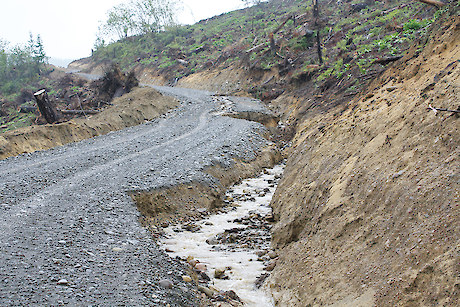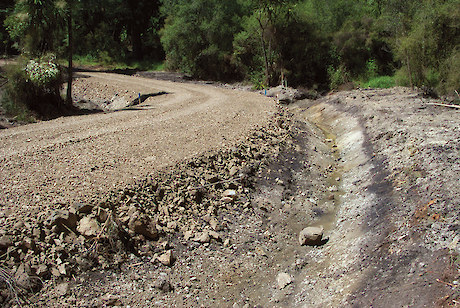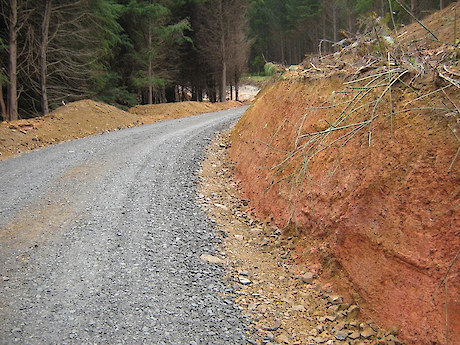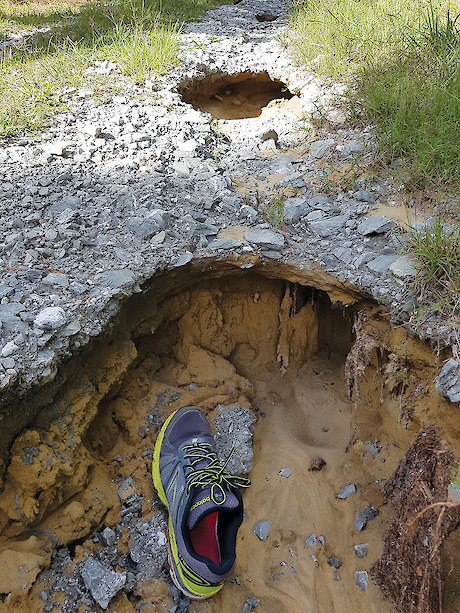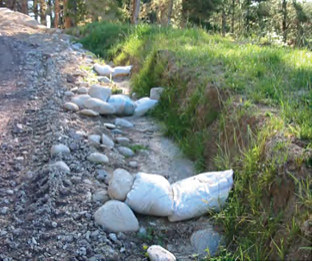Flat-bottomed ditch V-shaped ditch
V-shaped ditch Drainage functions of a ditch
Drainage functions of a ditch Ditches are normally constructed parallel to the road or landing, to channel and direct stormwater from cut banks or berms to an appropriate discharge point. Berms are constructed on the fill side of roads to control runoff. These will be discussed in sections 7.2 and 7.3.
Ditches are normally constructed parallel to the road or landing, to channel and direct stormwater from cut banks or berms to an appropriate discharge point. Berms are constructed on the fill side of roads to control runoff. These will be discussed in sections 7.2 and 7.3.
Ditches are often incorrectly called water tables or water table drains. The water table is a physical limit of where the water level lies, so this could be below or above the bottom of the ditch.
Ditches are usually designed with a flat bottom to minimize the potential for scouring and erosion from water flow. Alternatively, a v-shaped ditch may be used if the area has low rainfall and stable soil that will not scour. Examples of design specifications are shown in the adjacent diagrams. In some instances, a straight line from the crown of the road to the bottom of the ditch can be adopted. The advantage of this design is that it is quick and easy to maintain with a grader.
The longitudinal slope of the ditch is very important. A slope which is too shallow will not let water drain quickly, causing flooding and silting of the ditch bed. A slope that is too steep will allow fast water flow, resulting in scouring and erosion of the ditch. As a rule of thumb, a minimum slope of 0.5% (1:200) is recommended to avoid silting. The maximum slope of a ditch will be dictated by the road gradient.
Ditches serve three important drainage functions. They:
- Intercept and drain ground water flow through the cut slope, and surface flow over the cut slope
- Intercept and drain ground water infiltrating from the water table into the subgrade by capillary action
- Capture road surface drainage to prevent water infiltration into the road or landing surface. This keeps the road subgrade drier, making a stronger road. This function requires the road surface to have an appropriate camber (typically 4-6%) to be effective.
On major secondary and arterial roads, or in regions with high rainfall, the ditch depth should be maintained at least one metre below the subgrade surface, so that effective subgrade drainage and ground water interception is achieved.
Consider using rock armouring of ditches where there could be significant environmental risk from sediment or infrastructure failure. Armouring is lining the ditch bed with aggregate, preferably fractured to avoid rolling. This slows water flow and limits erosion, as the rock protects the ditch by reducing the energy of the water. Consider use when the culvert or cut-out spacing distance is restricted by terrain, for steeper gradient ditches where heavy rain could concentrate water flow and create erosion, or where ditches are in unconsolidated soils such as volcanic ash. Sediment traps and check dams can also assist in reducing water speed and its erosive power. Alternatively, road aggregate can also be used by applying it to the full width of the road formation including the ditch. Make sure that it is compacted, if possible. If standard road aggregate is not suitable, use a different aggregate after the subgrade is applied to the road surface. Ensure the aggregate is both large enough and placed deep enough to take stormwater flow. This avoids aggregate being displaced or washed into culverts, and blocking or partially blocking them.
Rock check dam specifications
Consider using check dams where ditches are prone to erosion, primarily due to water speed with a large volume flow. Check dams are very small temporary or semi-permanent dams constructed across a ditch and other water channels. They may be used in tandem with rock armour. The lowest point of the ditch should be below subgrade level, about 500 mm below the crown of the road. Check dams can be constructed from larger aggregate or sand bags filled with aggregate.
Ensure water goes over the middle of the dam and not around the edges, otherwise this will lead to scour. Do not make check dams higher or wider than the ditch itself. The diagram above provides rock dam specifications.
Another option is to use a polymer to make a ditch more resilient to erosion. Polymers can be applied to lock the soil particles together to prevent drainage water from eroding the ditch surface. Be mindful that polymers do not give permanent erosion control. Visit the following websites: www.rst.co.nz or www.vitalindustries.com.au.

